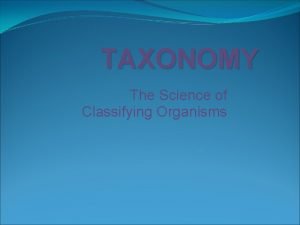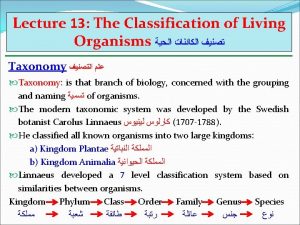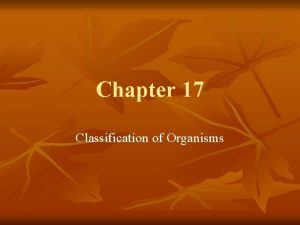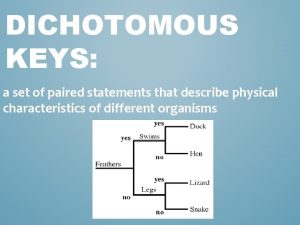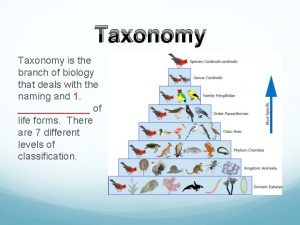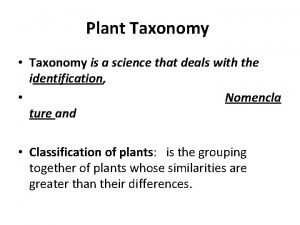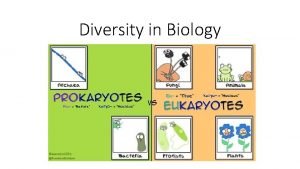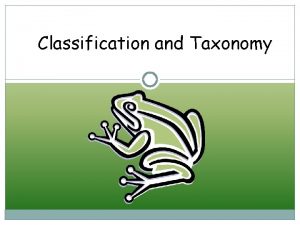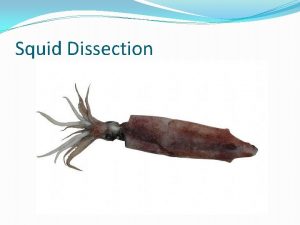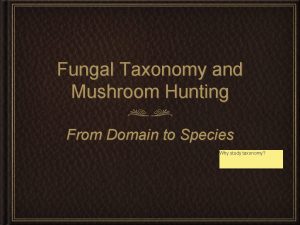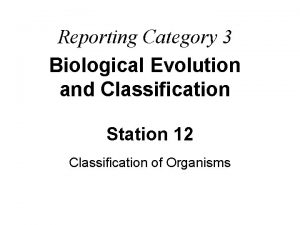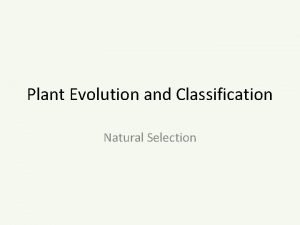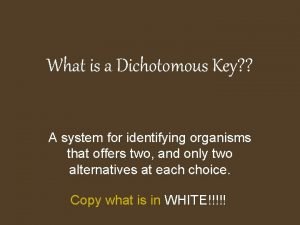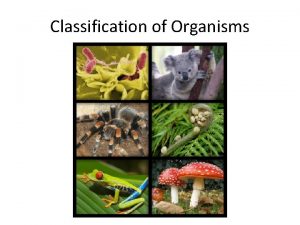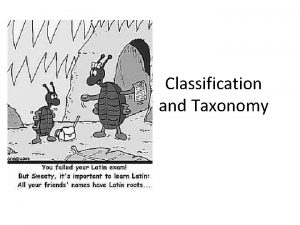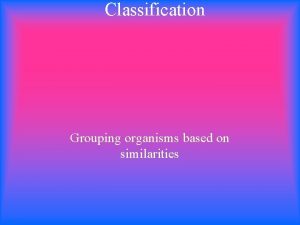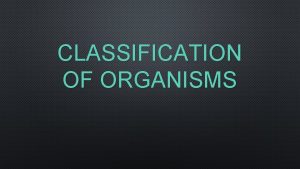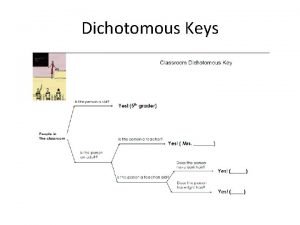EVOLUTION Taxonomy Science of classification of organisms Dichotomous



































- Slides: 35

EVOLUTION Taxonomy Science of classification of organisms

Dichotomous Keys A series of paired statements used to identify an organism (Do you know how to use a dichotomous key? )

8 Levels of Classification • • Domain Kingdom Phylum (Phyla-pl) or Division Class Order Family Genus (Genera-pl) Species (plants)

(Can you list the levels of classification in order? Remember: King Philip Came Over For Good Soup Do you understand the levels get smaller and more specific as you go down? )

Human Classification • Domain Eukarya • Kingdom Animalia • Phylum Chordata • Class Mammalia • Order Primates • Family Hominidae • Genus Homo • Species sapiens You don’t have to know the specific levels, except genus & species

Primates

Family Hominidae

Can you guess what these are? (Don’t have to know these. Examples. ) • Domain Eukarya • Kingdom Animalia • Phylum Chordata • Class Reptilia • Order Chelonia • Family Emydidae • Genus Terrapene • Species carolina Eukarya Animalia Arthropoda Insecta Diptera Culicidae Theobaldia anulata

First to classify organisms

Carolus Linnaeus The father of modern taxonomy – proposed binomial nomenclature

Old Scientific Name of European Honeybee • Apis pubescens, thorace subgriseo, abdomine fusco, pedibus posticis glabis, untrinque margine ciliatus

Today, its scientific name is • Apis mellifera

• Linnaeus developed binomial nomenclature – a two name system for writing scientific names • A scientific name is the organism’s genus and species

Why do biologists use scientific names? • Common names can be misleading • Scientific names are specific for each type of organism and can’t be confused

FROGMOUTH –does this look like a frog?

JELLYFISH – is it really a fish?

GUINEA PIGS – are they a type of pig?

SEA CUCUMBERS – are they plants or animals?

SEAHORSE – is it a horse?

ROBIN OR ROBIN? Which one are you referring to when you say robin?

LADYBUGS – are they all female? Are they bugs?

PINE TREE – which type of pine tree are you referring to? • Ponderosa? • Loblolly? • White? • Rocky Mountain? • Virginia?

DOMAINS • Since the bacteria are so different in their molecular structure, 2 domains are used to show their diversity • 3 Domains of living things v Bacteria (common prokaryotes v. Archaea (prokaryotes that live in harsh environments)

v. Domain Eukaryo • Kingdoms Protista, Fungi, Plantae, and Animalia are in the Domain Eukarya

Some Bacteria

Some Archaea

• Kingdom Protista – (protists); eukaryotes; some have cell walls; most unicellular; some autotrophs (make their own food) and some heterotrophs (take in food from the environment; some locomote and some immobile

Some Protists

• Kingdom Fungi – (fungi); eukaryotes; cell walls; most multicellular; heterotrophic; immobile

Some Fungi

• Kingdom Plantae – (plants); eukaryotes; cell walls of cellulose; multicellular; all autotrophs; immobile

Some Plants

• Kingdom Animalia – (animals); eukaryotes; no cell walls; multicellular; heterotrophs; nerves


Taxonomy is Constantly Revised • https: //www. m sn. com/enus/news/msn/n ew-sharkspeciesdiscovered-indepths-of-theatlantic/ar. BBJGzr. V New shark species discovered by analyzing DNA
 Taxonomy classification and dichotomous keys
Taxonomy classification and dichotomous keys Define dichotomous key
Define dichotomous key Sunflower classification
Sunflower classification Kendall and marzano new taxonomy example
Kendall and marzano new taxonomy example Organisms taxonomy
Organisms taxonomy Levels of classification
Levels of classification Crayfish taxonomy
Crayfish taxonomy Organisms taxonomy
Organisms taxonomy Taxonomy in biology
Taxonomy in biology Why do organisms interact with other organisms
Why do organisms interact with other organisms Multi and unicellular organisms
Multi and unicellular organisms Similar
Similar Lizard dichotomous key
Lizard dichotomous key What is your favourite subject?
What is your favourite subject? Taxonomy is the branch of science that deals with –
Taxonomy is the branch of science that deals with – Are coelenterates warm or cold blooded
Are coelenterates warm or cold blooded Taxonomy is the science that deals with _____.
Taxonomy is the science that deals with _____. Taxonomy is the science that deals with
Taxonomy is the science that deals with Crayfish taxonomy
Crayfish taxonomy Taxonomy of a cat
Taxonomy of a cat Classification of horse from kingdom to species
Classification of horse from kingdom to species Kingdom of a squid
Kingdom of a squid Mushroom domain
Mushroom domain Taxonomic classification of cat
Taxonomic classification of cat Canis latrans classification
Canis latrans classification Is protozoa prokaryotic or eukaryotic
Is protozoa prokaryotic or eukaryotic Living things grow images
Living things grow images Evolution of science
Evolution of science Category 3 biological evolution and classification
Category 3 biological evolution and classification Plants natural selection
Plants natural selection Why does a dichotomous key offer two choices
Why does a dichotomous key offer two choices Dichotomous key for leaves
Dichotomous key for leaves 6 kingdoms dichotomous key
6 kingdoms dichotomous key Dichotomous variables.
Dichotomous variables. Dichotomous variable
Dichotomous variable Dinosaur dichotomous key
Dinosaur dichotomous key




